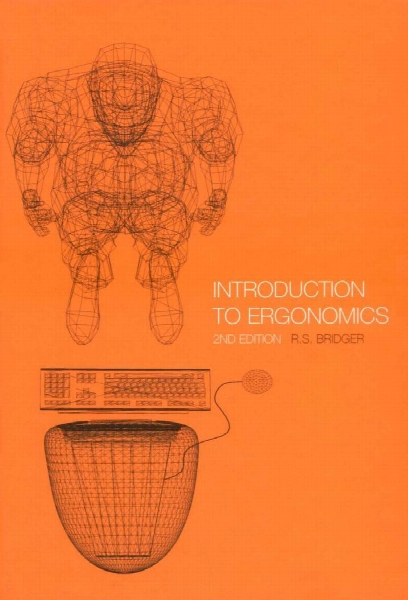Introduction to ergonomics
- نوع فایل : کتاب
- زبان : انگلیسی
- مؤلف : R S Bridger
- ناشر : London ; New York : Taylor & Francis
- چاپ و سال / کشور: 2003
- شابک / ISBN : 9780203426135
Description
Introduction 1 The focus of ergonomics 2 Ergonomics and its areas of application in the work system 10 A brief history of ergonomics 11 Attempts to ‘humanise’ work 19 Modern ergonomics 21 Effectiveness and cost effectiveness 26 Future directions for ergonomics 31 Summary 31 Essays and exercises 32 2 Anatomy, posture and body mechanics 33 Some basic body mechanics 34 Anatomy of the spine and pelvis related to posture 36 Postural stability and postural adaptation 42 Low back pain 44 Risk factors for musculoskeletal disorders in the workplace 48 Behavioural aspects of posture 53 Effectiveness and cost-effectiveness 55 Research directions 56 Summary 56 Essays and exercises 57 3 Anthropometric principles in workspace and equipment design 58 Designing for a population of users 58 Sources of human variability 58 Anthropometry and its uses in ergonomics 60 Principles of applied anthropometry in ergonomics 69 Application of anthropometry in design 76 Design for everyone 79 Anthropometry and personal space 83 Effectiveness and cost-effectivness 84 Research directions 86 Summary 86 Essays and exercises 87 4 Static work: Design for standing and seated workers 89 Fundamental aspects of standing and sitting 90 An ergonomic approach to workstation design 96 Design for standing workers 103 Design for seated workers 107 Worksurface design 110 Visual display units 112 Guidelines for the design of static work 113 Effectiveness and cost-effectivness 116 Research directions 118 Summary 119 Essays and exercises 120 5 Design of repetitive tasks 121 Introduction to work-related musculoskeltal disorders 121 Injuries to the upper body at work 128 Review of tissue pathomechanics and WMSDs 129 Disorders of the neck 134 Carpal tunnel syndrome 137 Tennis elbow (epicondylitis) 139 Disorders of the shoulder 140 Lower limbs 142 Ergonomic interventions 143 Trends in work-related musculoskeltal disorders 151 Effectiveness and cost-effectivness 153 Research directions 156 Summary 156 Essays and exercises 157 6 Design of manual handling tasks 158 Anatomy and biomechanics of manual handling 158 Prevention of manual handling injuries in the workplace 161 Design of manual handling tasks 171 Carrying 178 Effectiveness and cost-effectiveness 184 Research issues 186 viii Contents Summary 186 Essays and exercises 186 7 Work capacity, stress and fatigue 187 Stress and fatigue 187 Muscles, structure, function and capacity 188 The cardiovascular system 199 The respiratory system 200 Physical work capacity 200 Factors affecting work capacity 205 Effectiveness and cost-effectiveness 210 Research issues 212 Summary 212 Essays and exercises 213 8 Industrial applications of physiology 214 Measurement of the physiological cost of work 215 Applied physiology in the workplace 218 Fitness for work 223 Effectiveness and cost-effectiveness 228 Research issues 230 Summary 230 Essays and exercises 231 9 Heat, cold and the design of the physical environment 233 Fundamentals of human thermoregulation 233 Measuring the thermal environment 235 Thermoregulatory mechanisms 237 Work in hot climates 239 Work in cold climates 242 Skin temperature 246 Protection against extreme climates 247 Comfort and the indoor climate 250 ISO standards 256 Effectiveness and cost-effectiveness 256 Research directions 260 Summary 260 Essays and exercises 261 10 Vision, light and lighting 262 Vision and the eye 262 Measurement of light 274 Lighting design considerations 278 Visual fatigue, eyestrain and near work 286 Psychological aspects of indoor lighting 288 Effectiveness and cost-effectiveness 289 Research issues 293 Summary 293 Essays and exercises 293 11 Hearing, sound, noise and vibration 295 Terminology 296 The ear 296 Measurement of sound 303 Ear protection 309 Design of the acoustic environment 311 Industrial noise control 314 Noise and communication 317 The auditory environment outdoors 317 Effects of noise on task performance 318 Non-auditory effects of noise on health 319 Noise and satisfaction 320 Vibration 321 Effectiveness and cost effectiveness 323 Research issues 327 Summary 327 Essays and exercises 328 12 Human information processing, skill and performance 329 A general information processing model of the user 329 Cognitive systems 351 Problem solving 352 Effectiveness and cost-effectiveness 357 Research issues 358 Summary 358 Essays and exercises 358 13 Displays, controls and virtual environments 360 Principles for the design of visual displays 360 Auditory displays 375 Design of controls 379 Combining displays and controls 386 Virtual (‘synthetic’) environments 392 Effectiveness and cost-effectiveness 396 Research issues 399 x Contents Summary 399 Essays and exercises 400 14 Human–computer interaction, memory and language 401 Human-centred design processes for interactive systems 402 Designing information in external memory stores 407 Human-computer dialogues 413 Memory and language in everyday life 418 Effectiveness and cost-effectiveness 427 Research issues 433 Summary 434 Essays and exercises 434 15 Human–machine interaction, human error and safety 436 Human error and equipment design 436 Mental workload in human machine interaction 442 Psychological aspects of human error 445 Characterising human–machine interaction 454 GOMS 459 Prevention of error in human–machine interaction 460 Accidents and safety 467 Effectiveness and cost-effectiveness 471 Research issues 475 Summary 476 Essays and exercises 476 16 System design: organisational and social aspects 477 Systems design methods for ergonomics 477 Organisational aspects: some macroergonomic examples 481 Psychosocial factors 495 Litigation 503 Cross-cultural considerations 504 Effectiveness and cost-effectiveness 505 Research directions 507 Summary 507 Essays and exercises 508 Further reading 509 References 511 Index 543


